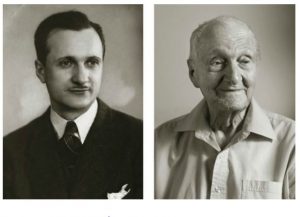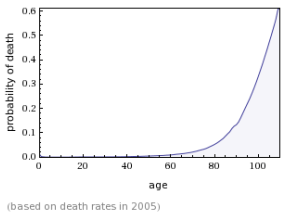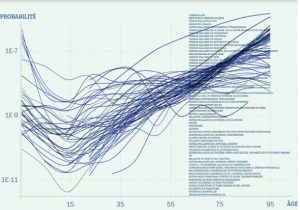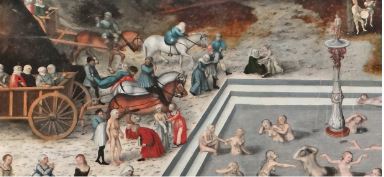The death of individuals is the way species adapt to changes in the environment through natural selection. Once mankind will have full control of its environment, death will no longer have the same reasons to be. Because of the Baldwin effect, natural selection will continue to act on genes. It will favor longevity. It will promote longevity. This one will therefore continue to increase steadily. Extract from « The Thermodynamics of Evolution » by François Roddier.
Theme of the month: dormancy, hibernation… and lives naturally lived in slow motion
Cellular organisms have been living, reproducing and dying for  hundreds of millions of years. Hundreds of millions of life cycles have followed one another. Life, as we intuitively understand it, is a set of complex mechanisms by which each entity maintains its integrity, maintains its metabolism, through multiple and abundant exchanges with the outside world.
hundreds of millions of years. Hundreds of millions of life cycles have followed one another. Life, as we intuitively understand it, is a set of complex mechanisms by which each entity maintains its integrity, maintains its metabolism, through multiple and abundant exchanges with the outside world.
But in many living species, under certain circumstances, life (to paraphrase the poet Lamartine) « suspends its flight ». In other words, the metabolism slows down considerably.
This letter will detail the main categories of « natural » slow-motion lives, with the exception of sleep. (This fascinating way of living in slow motion that we experience every night was addressed in a letter in January 2016.)
Hibernation and dormancy
Hibernation is the most common case of slowed-down life. During the cold season, some mammals, including marmots and a species of bird (the common poorwill), take refuge underground or in crevices and live with an extremely slow metabolism: body temperature at one or two degrees, heart rate of a few beats per minute…
For poikilothermic (cold-blooded) vertebrates, a similar phenomenon is called brumation. The wood frog can even survive partially frozen. For insects, the mechanism similar to hibernation is called diapause.
Finally, as we all know, many plants lose their leaves in winter (or in the dry season). The technical term is a deciduous plant and the period of slowed-down activity is called dormancy.
Grains and seeds
In this case we are talking about such a « slow » life that we do not generally consider it life at all. Under normal circumstances, for plants living in areas with different seasons, a seed will have a virtually non-existent metabolism during the season that is not favorable to growth.
The term dormancy is also used here. Usually, dormancy lasts only a few months and the plant is « born » in the summer. But if the germination conditions are not met but preservation conditions are good, some seeds can remain fertile for centuries and even millennia. Some seeds from a date palm found in the fortress of Masada in Israel germinated after two millennia.
Spores
A spore is a tiny entity usually made up of a single cell that can give rise to an organism. Many algae, fungi, protozoa and plants produce spores.
In ideal preservation conditions, a spore can produce an organism after thousands of years. It even seems that bacterial spores can remain inside rocks for millions of years. The record is said to be 240 million years. However, this is not certain. In the case of such extremely resistant forms of dormant life, it may be that the spores arrived by « contamination » when the rocks were examined.
Underground life
According to a very recent statement by the Deep Carbon Observatory, an almost inanimate microbial ‘zombie’ life is maintained for millennia at great depth (up to 2 kilometers underground). The total biomass is estimated to far exceed the weight of humans. At lesser depths, in the Siberian permafrost, there have been found nematode worms that were « brought back to life » after 40,000 years.
But this is not transferable to humans
All this reminds us how living beings are often more resistant than humans and to what extent death from aging is not a universal phenomenon. The study of the mechanisms of these longevities will not give us direct instructions for a longer human life, but can give us ideas so to allow us one day to have more resilience.
New of the month: Did Jeanne Calment really live to be 122?
The small world of specialists in extreme longevity is being rocked by controversy. Some are stating that Jeanne Calment, who died in 1997, was an impostor. Officially her daughter Yvonne died aged 35 when Jeanne was in her sixties but some people think that in fact the daughter was switched with the mother. The person known as Jeanne Calment therefore actually died shortly before reaching 100, it is claimed.
In support of the claim:
- There were no other centenarians in the Calment family. And yet the genetic aspect is important in centenarians.
- The supposed age reached by Jeanne Calment was and still is totally atypical (more than two years older than the second longest-lived person).
- Jeanne Calment was rich and there was therefore an advantage, in particular, to hiding her death so as to avoid inheritance tax. Jeanne Calment has also remained famous for having sold her home en viager [an arrangement where the seller stays in the home for life and receives a lump sum and ongoing payments from the purchaser]. This type of contract is uncommon, but it would make sense if there had been deception over Jeanne Calment’s death.
On the other hand:
- Jeanne Calment’s case is abundantly documented. In the event of fraud, at least Jeanne Calment’s husband should have been aware of it almost certainly as well as other family members and relatives.
- It seems unlikely that Yvonne Calment, who supposedly pretended to be Jeanne Calment, could have lied (or possibly after a while lied to herself) for more than 60 years without anything wrong being detected despite her very numerous contacts, notably with journalists.
- The person who was to receive Jeanne Calment’s property upon her death would have had every advantage in reporting the fraud because he could have had the life annuity canceled. At the death of this notary, his widow who continued to pay would also have benefited.
So there are good reasons for doubt in both cases. It would be useful for science to analyze the DNA of the person buried in 1997 (by comparing it with the DNA of family members). If Jeanne Calment did live 122 years, we will have extremely useful genetic elements to decipher and, if not, we will know that supercentenarians are an even rarer phenomenon than we think today.
Unfortunately, research for longevity is not yet perceived as important enough. It is easier to examine the DNA of royal families than that of presumed supercentenarians.
To find out more:
- In general, see in particular: heales.org, sens.org, longevityalliance.org et longecity.org
- Source of the photo : wood frog hibernating

 Very often, those to whom we talk about human longevity imagine a world of decrepit old people with no energy. However, scientific research on aging aims to reduce and even stop the aging processes.
Very often, those to whom we talk about human longevity imagine a world of decrepit old people with no energy. However, scientific research on aging aims to reduce and even stop the aging processes.




 William Makeham
William Makeham




